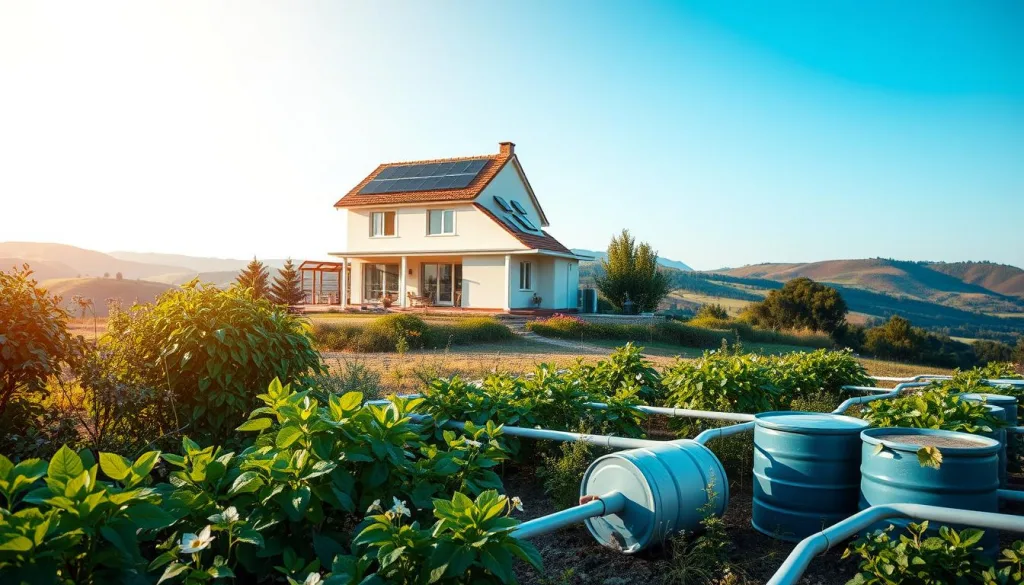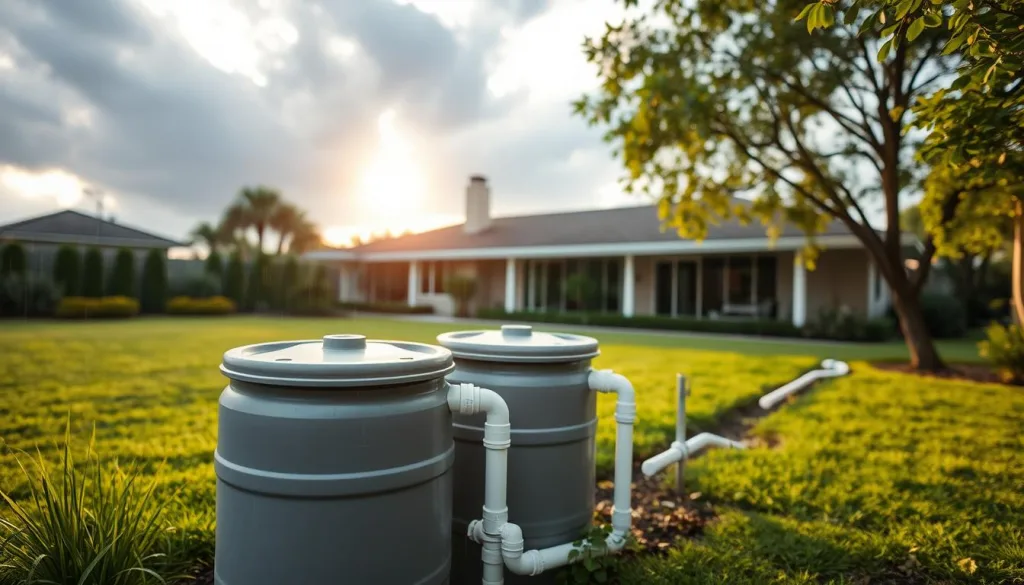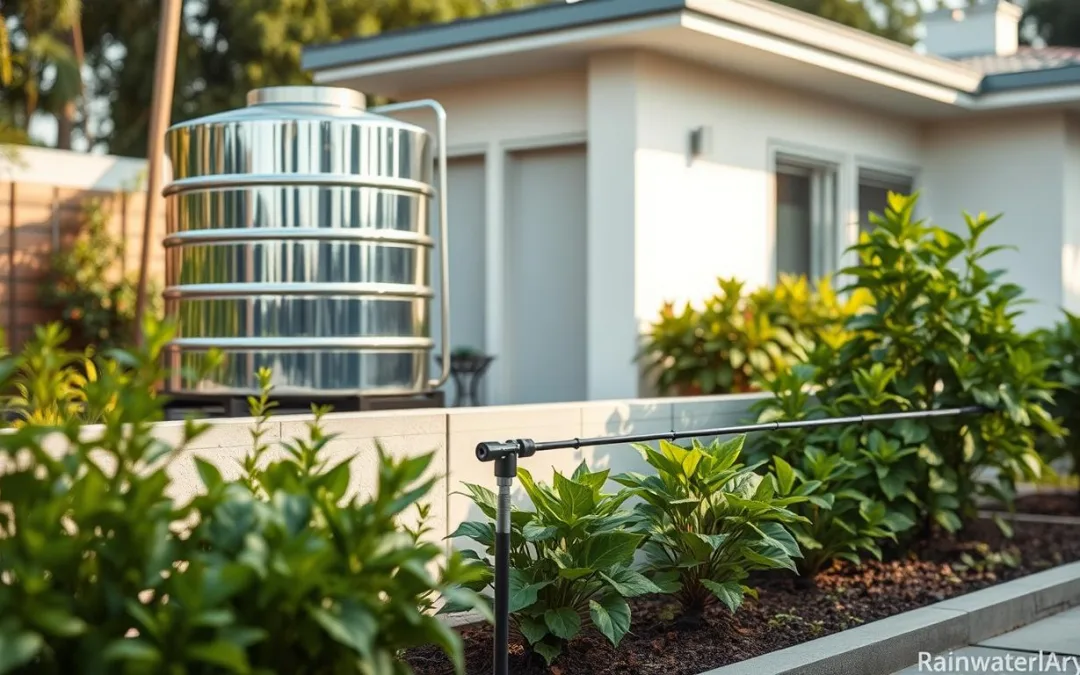Rainwater harvesting is a key strategy for saving water. It changes how we think about water in cities. Up to 90% of rainwater in cities goes to waste, flowing off hard surfaces like roads and roofs.
This method lets people and communities collect, store, and use rainwater for things other than drinking. It’s great for gardens and farms, making it a green choice compared to using regular water sources.
Using these systems can cut down on the need for city water, lower your water bills, and help the environment. It’s not just good for homes; it can also help avoid big public water projects.
Key Takeaways
- Reduces municipal water dependency
- Lowers household water expenses
- Minimizes stormwater runoff
- Supports environmental sustainability
- Provides alternative water source for non-drinking uses
Understanding Rainwater Harvesting Systems
Rainwater harvesting systems are a smart way to save water. They turn rain into a useful resource. Homeowners and communities can benefit a lot from these systems.
At its heart, a rainwater harvesting system collects and stores rainwater for later use. The Federal Energy Management Program sees these systems as a good alternative to traditional water sources. They help reduce the need for fresh water.
What is a Rainwater Collection System?
A rainwater collection system captures rain from roofs, stores it, and uses it again. It’s more than just saving water. It also brings many benefits to homes and businesses.
Key Components of Harvesting Systems
- Catchment surfaces (typically roofs)
- Gutters and downspouts
- Filtration systems
- Storage tanks or cisterns
- Distribution mechanisms
Types of Collection Methods
There are many ways to collect rainwater, each with its own benefits. From simple rain barrels to complex systems, they all help manage water better.
| Collection Method | Primary Use | Complexity Level |
|---|---|---|
| Rain Barrels | Garden Irrigation | Low |
| Comprehensive Roof Systems | Household Water Supply | High |
| Commercial Collection Systems | Large-Scale Water Management | Very High |
The Texas Manual on Rainwater Harvesting suggests a collection rate of 75% to 90%. By using these systems, property owners can cut down on their use of municipal water. They also help with sustainable water management.
The Benefits of Rainwater Harvesting
Rainwater harvesting brings many benefits for homeowners and communities. It’s not just about collecting water. It offers environmental, economic, and practical advantages that change how we use water.
Let’s look at the main benefits of using rainwater again:
- Water Conservation: It cuts down on the need for city water. In areas with lots of buildings, only 15% of rainwater soaks into the ground. Harvesting rainwater is key to saving water.
- Cost Savings: Using rainwater can lower your water bills a lot. You could save up to 50% of what you pay for city water in some places.
- Environmental Protection: It reduces stormwater runoff by up to 60%. This helps prevent flooding and keeps water clean.
The good it does for the environment is huge. Rainwater is naturally clean, without the salts and chemicals found in city water. It’s perfect for plants and helps cool cities by supporting plants and natural water cycles.
Rainwater harvesting also helps communities be more resilient. It eases the pressure on city water systems. This leads to more sustainable water use and helps solve water scarcity problems.
Rainwater harvesting isn’t just a water collection method—it’s a commitment to sustainable living and responsible resource management.
Environmental Impact and Sustainability Advantages
Rainwater harvesting is a key strategy for saving water. It helps communities use water more wisely. This approach changes how we handle water from nature.
This method does more than just collect water. It’s vital for keeping local ecosystems healthy. It also helps lessen environmental stress.
Reduction in Stormwater Runoff
Rainwater harvesting cuts down on stormwater runoff. This runoff can harm the environment. By catching rain, these systems stop:
- Surface water contamination with pesticides
- Sediment and metal pollution
- Fertilizer runoff into natural waterways
Erosion Prevention Benefits
Collecting rainwater helps prevent erosion. It does this by:
- Lowering the amount of water flowing
- Slowing down water in streams
- Keeping riverbanks safe
Decreased Carbon Footprint
Rainwater harvesting also cuts down on carbon emissions. It saves energy by reducing the need for water treatment and distribution. This helps protect our climate.
The O2 Arena in London is a great example. It collects rainwater from a huge 90,000 m² area. This shows how big rainwater harvesting can be.
Using rainwater harvesting is a smart way to care for our planet. It offers real benefits for both local and global environments.
Economic Advantages of Water Collection

Rainwater harvesting is a smart choice for those looking to save money and protect the environment. It offers many benefits, from saving on water bills to reducing the need for expensive water treatment plants.
Homeowners can save a lot of money by using rainwater for daily tasks. For example, a good system can collect up to 90,000 liters of water each year. This water is perfect for flushing toilets and washing clothes.
- Reduces municipal water dependency
- Lowers household water expenses
- Creates sustainable job opportunities
- Minimizes infrastructure development costs
Communities also benefit a lot from rainwater harvesting. In South East Queensland, using rainwater on 90% of new buildings could create 800 jobs. This could save the community up to $3.5 billion by 2056.
| Economic Metric | Potential Savings |
|---|---|
| Household Water Bills | $2.5 Billion |
| Infrastructure Reduction | Up to 50% Smaller Treatment Plants |
| Greenhouse Gas Emissions | 40% Reduction |
Investing in rainwater harvesting is a smart move for both individuals and communities. It not only saves money but also helps the environment. This approach makes water management more sustainable and cost-effective in the long run.
Water Conservation and Management Benefits
Sustainable water management is more than just the usual ways. Rainwater harvesting is a key strategy for eco-friendly water conservation. It changes how we use water resources.
Rainwater harvesting has many benefits for water management. Let’s look at the main advantages:
- Reduces dependency on municipal water supplies
- Provides emergency water resources during critical periods
- Minimizes strain on existing water infrastructure
Reducing Municipal Water Dependency
Rainwater harvesting can cut down on treated municipal water use. Communities using these systems can save up to 40% on water. This has big environmental and economic benefits.
Emergency Water Supply Solutions
During droughts or disasters, stored rainwater is vital. Homeowners can keep water access when usual supplies fail. This ensures safety and resilience.
Peak Demand Management
Utilities struggle in summer when water demand is highest. Rainwater harvesting helps by:
| Management Strategy | Water Conservation Impact |
|---|---|
| Residential Collection | Reduces peak municipal water demand by 30-40% |
| Landscape Irrigation | Decreases treated water consumption significantly |
| Emergency Preparedness | Provides alternative water sources during shortages |
Strategic water management through rainwater harvesting is a forward-thinking approach to sustainable resource utilization.
Practical Applications in Home and Garden

Rainwater collection does more than save water. It turns rainwater into a useful tool for gardens and homes. This makes it a valuable resource for many tasks.
Irrigation is a big win for using rainwater. Soft, chemical-free rainwater is great for plants. It helps them grow better without the bad stuff found in city water.
- Garden watering with zero chlorine or fluoride
- Landscape irrigation improvements
- Non-potable indoor water usage
- Potential potable water supply with proper treatment
“Rainwater is nature’s perfect irrigation solution – pure, soft, and free from municipal water treatment chemicals.”
Homeowners can add rainwater systems to their homes. This water is good for flushing toilets, washing clothes, and cleaning outside. Rainwater doesn’t harden water, which means appliances last longer and you use less detergent.
| Application | Water Savings |
|---|---|
| Garden Irrigation | 40-60% less city water |
| Toilet Flushing | 20-30% less water used |
| Laundry | 15-25% less water used |
Using rainwater smartly can cut down on water bills. It also helps the environment and supports sustainable water use.
Water Quality Benefits and Natural Purity
Rainwater harvesting brings many benefits that traditional methods can’t match. Eco-friendly water conservation starts with understanding rainwater’s special qualities.
Rainwater is a top-notch water source with amazing natural traits. It’s much cleaner than municipal water, which often has many contaminants. This makes rainwater a great choice for many household uses.
Chemical-Free Water Advantages
The natural purity of rainwater offers big benefits for home use:
- Free from municipal water treatment chemicals
- Exceptionally low Total Dissolved Solids (TDS)
- No added chlorine or fluoride
- Naturally soft water characteristics
Benefits for Plant Growth
Gardeners and plant lovers value rainwater’s special qualities. Naturally soft and chemical-free, it gives plants the best hydration. This helps plants grow well without harming the soil.
Appliance Longevity Benefits
Using rainwater can make your appliances last longer. Studies show soft water keeps appliances working well. This can even help your water heater last up to 15 years longer.
Rainwater: Nature’s purest water source, delivering unparalleled quality and sustainability.
Implementation Strategies and Best Practices
Creating a good rainwater harvesting system needs careful planning. Rooftop harvesting is common in cities because it’s easy and doesn’t need much setup. First, check your property’s water needs and local rain patterns to make your system work best.
A rainwater system has key parts: a catchment area, a way to move water, filters, storage, and treatment after storage. Companies like Rainwater Management Solutions have many systems, from small kits to big underground setups. The World Bank says using rainwater wisely can cut down on city water use and help the environment.
Teaching people about rainwater harvesting is important. Learning about different ways to collect and use rainwater helps homeowners. This can save money, too, in places where water costs a lot.
Keeping your system in good shape is essential. Regular checks, clean filters, and knowing local rules will keep your system working well. From simple barrels to big systems, they all help save water and support green projects.
FAQ
What exactly is rainwater harvesting?
How much money can I save by implementing a rainwater harvesting system?
Is rainwater safe for use in my garden and landscape?
What types of rainwater harvesting systems are available?
How does rainwater harvesting help the environment?
Can rainwater be used for drinking?
What maintenance do rainwater harvesting systems require?
Are there government incentives for installing rainwater harvesting systems?
How much rainwater can I typically collect?
What are the initial costs of installing a rainwater harvesting system?
FAQ
What exactly is rainwater harvesting?
Rainwater harvesting is a way to collect and use rainwater. It captures rain from rooftops and stores it in tanks. This water is then used for irrigation, household needs, or even drinking with treatment.
How much money can I save by implementing a rainwater harvesting system?
Savings depend on your location and system size. Homeowners can cut their water bills by 30-50%. You might save 0-0 a year, and more by using less municipal water.
Is rainwater safe for use in my garden and landscape?
Yes, rainwater is great for gardens. It’s soft, free from chemicals, and has a pH plants like. It’s perfect for plant growth and health.
What types of rainwater harvesting systems are available?
There are many types, from simple rain barrels to whole-house systems. You can collect from rooftops, surfaces, or use plumbing systems for irrigation and more.
How does rainwater harvesting help the environment?
It reduces stormwater runoff and erosion. It also lowers carbon footprint and strain on water systems. It’s good for local ecosystems and saves water.
Can rainwater be used for drinking?
Yes, but it needs proper treatment. You’ll need filters, regular tests, and follow health rules. Most systems start with non-potable uses like irrigation.
What maintenance do rainwater harvesting systems require?
Maintenance includes cleaning surfaces and tanks, checking filters, and ensuring water quality. Annual inspections by pros are key to keeping the system working well.
Are there government incentives for installing rainwater harvesting systems?
Yes, many places offer tax credits, rebates, or grants. Check with local water authorities and agencies for what’s available in your area.
How much rainwater can I typically collect?
It depends on your roof size and local rain. One inch of rain on a 1,000 square foot roof yields about 600 gallons. Your annual collection can be thousands of gallons.
What are the initial costs of installing a rainwater harvesting system?
Costs vary from 0 for a rain barrel to ,000 for a whole-house system. Basic systems cost
FAQ
What exactly is rainwater harvesting?
Rainwater harvesting is a way to collect and use rainwater. It captures rain from rooftops and stores it in tanks. This water is then used for irrigation, household needs, or even drinking with treatment.
How much money can I save by implementing a rainwater harvesting system?
Savings depend on your location and system size. Homeowners can cut their water bills by 30-50%. You might save $300-$800 a year, and more by using less municipal water.
Is rainwater safe for use in my garden and landscape?
Yes, rainwater is great for gardens. It’s soft, free from chemicals, and has a pH plants like. It’s perfect for plant growth and health.
What types of rainwater harvesting systems are available?
There are many types, from simple rain barrels to whole-house systems. You can collect from rooftops, surfaces, or use plumbing systems for irrigation and more.
How does rainwater harvesting help the environment?
It reduces stormwater runoff and erosion. It also lowers carbon footprint and strain on water systems. It’s good for local ecosystems and saves water.
Can rainwater be used for drinking?
Yes, but it needs proper treatment. You’ll need filters, regular tests, and follow health rules. Most systems start with non-potable uses like irrigation.
What maintenance do rainwater harvesting systems require?
Maintenance includes cleaning surfaces and tanks, checking filters, and ensuring water quality. Annual inspections by pros are key to keeping the system working well.
Are there government incentives for installing rainwater harvesting systems?
Yes, many places offer tax credits, rebates, or grants. Check with local water authorities and agencies for what’s available in your area.
How much rainwater can I typically collect?
It depends on your roof size and local rain. One inch of rain on a 1,000 square foot roof yields about 600 gallons. Your annual collection can be thousands of gallons.
What are the initial costs of installing a rainwater harvesting system?
Costs vary from $100 for a rain barrel to $10,000 for a whole-house system. Basic systems cost $1,000-$3,000. The long-term savings and benefits often make up for the cost.
,000-,000. The long-term savings and benefits often make up for the cost.
Source Links
- Rainwater Harvesting: 5 Advantages & Disadvantages | Accurate Leak & Line – https://www.accurateleak.com/blog/5-advantages-of-rainwater-harvesting-2/
- Top 6 Advantages of Rainwater Harvesting in 2024 – https://resolutecivils.com/6-benefits-and-advantages-of-rainwater-harvesting/
- The Many Benefits and Advantages of Rainwater Harvesting – https://www.watercache.com/faqs/rainwater-harvesting-benefits?srsltid=AfmBOoo1ua_mHqJI4bpzCM2zkHj3e9NSb2KO80_V0Xbl6bTkZNyjrJGI
- Rainwater Harvesting Systems Technology Review – https://www.energy.gov/femp/rainwater-harvesting-systems-technology-review
- The Many Benefits and Advantages of Rainwater Harvesting – https://www.watercache.com/faqs/rainwater-harvesting-benefits?srsltid=AfmBOoq9yZ0fDi_4bRvr_mCmeaJt0IQPfVbF2lG0aBqvCIjgKGYIwNxd
- Environmental Benefits of Rainwater Harvesting & Rain Barrels – https://www.bluebarrelsystems.com/blog/environmental-benefits-of-rainwater-harvesting/
- The Many Benefits and Advantages of Rainwater Harvesting – https://www.watercache.com/faqs/rainwater-harvesting-benefits?srsltid=AfmBOopjIuOCaC7JGwfHKa7h1w9HEXaoXnoP9dYh4I_2n5HofkY68_Yp
- Rainwater Harvesting -Process, Advantages and Disadvantages – https://byjus.com/biology/rainwater-harvesting/
- The environmental impact of rainwater harvesting and using water tanks at home – https://smartwateronline.com/news/the-environmental-impact-of-rainwater-harvesting-and-using-water-tanks-at-home?srsltid=AfmBOor9zkY15QCOkDkqYkrYScSpXV6_gPqI_x1GVMWqfuwjllvgRrct
- The Amazing Benefits of Rainwater Harvesting | EcoMENA – https://www.ecomena.org/rainwater-harvesting/
- The Many Benefits and Advantages of Rainwater Harvesting – https://www.watercache.com/faqs/rainwater-harvesting-benefits?srsltid=AfmBOor3CiJfVX93qAtV7Uc6SVLfn3OBWMvA7qZEBH4pKkX9kYRC8MXy
- Socio-Economic Benefits to Rainwater Harvesting: Councils, Community and Individuals | Clark Tanks Poly Water Tanks – https://clarktanks.com.au/2018/04/04/socio-economic-benefits-to-rainwater-harvesting-councils-community-and-individuals/
- The Many Benefits and Advantages of Rainwater Harvesting – https://www.watercache.com/faqs/rainwater-harvesting-benefits?srsltid=AfmBOoqOD5ZRmopXf3jiK8PgtshOWocifVll_o9YvPVD7hm_SogHkhsg
- 11 Rainwater Harvesting Benefits for Water Conservation – https://www.ny-engineers.com/blog/rainwater-harvesting
- The Many Benefits and Advantages of Rainwater Harvesting – https://www.watercache.com/faqs/rainwater-harvesting-benefits?srsltid=AfmBOoqKQrzU-mq8RIo4upNtnaMSfTju3_JsOsSUzDDoYQXsOX9ZLsyM
- 8 Ways Rainwater Harvesting Can Benefit American Farmers, Homeowners, and Property Owners – https://smartwateronline.com/news/8-ways-rainwater-harvesting-can-benefit-american-farmers-homeowners-and-property-owners?srsltid=AfmBOopuXDCsdffsWymXUDm5ur4udIgXbW_ja5NosHxUAJHXHQ1upvFs
- The Benefits of Rainwater Harvesting – https://4perfectwater.com/blog/benefits-of-rainwater-harvesting
- What is Rainwater Harvesting and its Benefits? – https://www.watercache.com/faqs/rainwater-harvesting-defined?srsltid=AfmBOoo-cijopHW8YF5qfpl099QVKaSeTwsLR53wuMZb-_14J34WVK5P
- Rainwater Harvesting 101 – https://rainwatermanagement.com/blogs/news/rainwater-harvesting?srsltid=AfmBOoq95qkx6qmd3XlnzYatYvvyeGOr0hgCF6hJ1nnyCpAoEOaLmeg7
- The Many Benefits and Advantages of Rainwater Harvesting – https://www.watercache.com/faqs/rainwater-harvesting-benefits?srsltid=AfmBOorMbDZG8RNU-JiWX-SXvLfDK3T7t8BvH8DyZVsFwifOzp4KNabk


